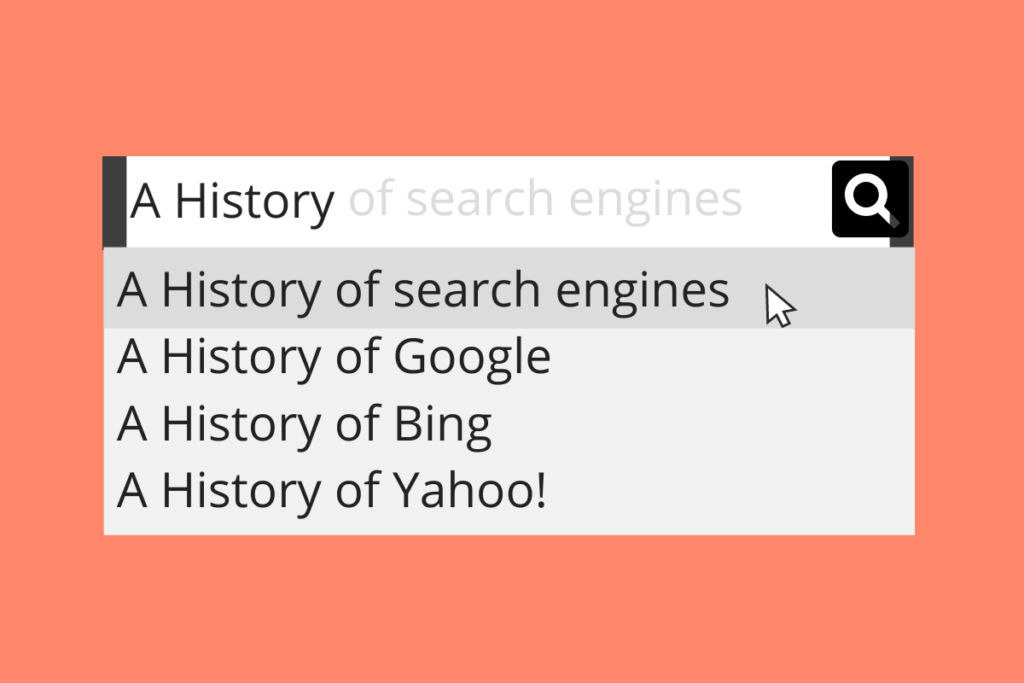
Updated post from March 6, 2008
The mystery of search engine algorithms begins to unravel when one studies their history. From 1994 through 2003, brilliant software engineers combined Mathematics, English, and organization skills in an effort to help users find what they needed on the Internet.
We’ve Come a Loooong Way
Do you remember your first home computer?
In 1981, the TI-99 and Commodore 64 personal computers were all the rage. You had to type in your own programs using the Basic language and save the programs and data on a cassette using a cable connected to a cassette recorder.
If the power happened to go out 5 hours into the creation of your program (or if your young daughter decided she wanted to play on your computer), you would lose it all.
Then, as a personal home computer user, you may have upgraded to an HP PC. By 1994, an HP 486 could save programs and data right on the computer and print out copies on its own black and white printer—amazing!
And, to make it even more exciting, this computer could actually go on the Internet! The Internet–it was the new frontier, where no man had gone before!
But once online, it was like being in virtual outer space! New users had to find out how to navigate this new and mysterious World Wide Web. Quite often, they were limited to sites they already knew and would get lost in the virtual universe.
Thankfully, Search Engines, invented by the best and the brightest computer programming engineers, were developed to help us find what we were looking for. Search engines gave us the freedom to search the Net!
» Early Search Engines were Maintained Manually
Some early search engines were created and maintained manually, by humans. This made them very expensive, slow to change, and somewhat subjective. The number of sites they could index was limited, so they had to pick and choose the sites they thought would be important and/or popular.
And, with the phenomenal rate of growth experienced by the World Wide Web, they couldn’t possibly keep up.
The Archie Legacy
» The First Search Engine was Developed for FTP Sites
The first search engine invented was “Archie”, created in 1990 by Alan Emtage, a brilliant student at McGill University in Montreal. The original intent of the name was “archives,” but it was shortened to Archie. This was before the creation of the World Wide Web, and was a search engine for FTP sites.
» Mathematics and English Unite! Statistical Analysis of Word Relationships
In February 1993, 6 Stanford students had the idea of using statistical analysis of word relationships to make searching more efficient. They soon received funding for their project, Architext, and in mid-1993 they released copies of their search software. This was gobbled up by Excite™.
» Counting Web Server Idea spawned Capturing URLs and Indexing
In June 1993, Matthew Gray introduced the World Wide Web Wanderer. At first, he wanted to measure the growth of the web and created the WWWW bot to count active web servers. It was just like a robot sent out to collect data on the moon!
Later, he upgraded the bot to capture actual URLs. His database became known as the Wandex—a welcome new inhabitant of planet Earth, online.
In October of 1993, Martin Koster created an Archie-Like Indexing of the Web, or ALIWEB, in response to the Wanderer. ALIWEB crawled meta information and allowed users to submit pages they wanted indexed with their own page description. ALIWEB didn’t need a bot to collect data and was not using a lot of bandwidth.
The downside of ALIWEB was that many internet marketing promotion and advertising webmasters had no idea how to submit their sites.
Creating History with the Bot Boom

JumpStation gathered info about the title and header from web pages and retrieved these by using a simple linear search. As the web grew, JumpStation could not keep up and eventually slowed to a stop.
The WWW Worm was great because it indexed both titles and URL’s. Unfortunately, JumpStation and the World Wide Web Worm listed results in the order they found them. Since early search engines did not do link analysis or cache full pages, if you did not know the exact name of the site you were looking for, you might not ever find it.
» Yahoo!™ Celebrated its 25-year Anniversary in March 2020
In 1994, Yahoo! was created by Jerry Yang and David Filo. It started as a listing of their favorite websites but each entry, besides the URL, also had a page description. With companies eager to invest in Internet opportunities, Yang and Filo received funding within a year, and Yahoo!, the corporation, was created. Yahoo! celebrated their 25-year anniversary in March 2020. Congratulations, Yahoo!
» WebCrawler—First to Index Entire Pages
On April 20, 1994, Brian Pinkerton of the University of Washington released the first crawler to index entire pages, called WebCrawler. Soon it became so popular that it could only be used at night when fewer people were trying to use it. An appropriate nickname would have been NIGHT CRAWLER. WebCrawler was eventually bought by AOL™.
» Monstrous Lycos™ added Prefix Matching and Word Proximity to Search Results
On July 20, 1994, a monstrous new search engine named Lycos went public with a catalog of 54,000 documents. Besides providing results ranked by relevance, Lycos’ algorithm also used prefix matching and word proximity (very important in organic search engine optimization even now) in their search engine placement.
The main advantage that Lycos had was its huge size. By August of 1994, Lycos had indexed 394,000 documents, by January 1995, it had 1.5 million documents, and by November 1996, Lycos had over 60 million documents.
If these documents were printed out and stacked on top of one another, they would reach… well, you get the idea. This was more pages indexed than any other Web search engine in history.
» Infoseek™ Offered Web Site Search Engine Submission
Infoseek, also started in 1994, offered a few extra features, such as allowing internet marketing promotion and advertising specialists and other webmasters to submit their own pages to the search index.
In December 1995, Netscape agreed to use them as their default search, which instantly gave them increased popularity. Unfortunately, spammers soon took advantage of Infoseek’s generosity and made it virtually impossible for searchers to get useful results.
» AltaVista™ Claimed Unlimited Bandwidth and Taught Search Tips
Next came AltaVista, with nearly unlimited bandwidth at the time.
They were the first to have advanced searching techniques, even offering useful search tips to teach new search engine techniques and help users get better results. By November 1997, Altavista, claimed that it handled roughly 20 million queries per day.
On May 20, 1996, the Inktomi Corporation launched its Hotbot search engine. Hotwire listed this search engine, and it too became very popular. In 2003, Inktomi was purchased by Yahoo!
Yes, the Bot Boom resulted in many new automated search engines with the capability of handling the large number of sites and searches that were being done. Although they were an improvement, many search engine queries still returned lists of non-related information, or “junk” results. A search for Mars could have returned sites on Venus!
Back to Natural
» Ask Jeeves™ Used Human Editors
In April of 1997, Ask Jeeves was launched as a natural language search engine. Users were invited to use a complete question to find more relevant answers. Ask Jeeves, using DirectHit technology, used human editors to try to match search queries. You could Ask Jeeves, “Does Mars Have Any Water?” if you wanted to know.
» Teoma™ Developed Clustering Techniques to Determine Site Popularity
In 2000, the Teoma search engine was released. Teoma used “clustering” to organize sites by Subject Specific Popularity—they tried to find local web communities in order to find relevant sites. In 2001, Ask Jeeves swallowed up Teoma to replace their DirectHit search technology. In 2006, Ask Jeeves was renamed to Ask and Teoma was digested.
The History of Google™
» BackRub Analyzed Links Pointing to a Site
By January of 1996, Larry Page and Sergey Brin, both brilliant graduate students at Stanford University, had begun to work together on a search engine called BackRub.
Not referring to what these explorers needed and deserved after the many hours they spent hunched over their keyboards, BackRub was actually named for its ability to analyze the “back links” pointing to a given website. BackRub ranked pages using “citation notation”.
In academic works, if someone cites a source, they usually think it’s important. On the web, citations are often links to a resource page. In BackRub’s PageRank algorithm, all links counted as votes, but some votes counted more than others. The ability of a given web page to rank, and the strength of its ability to vote for others, depended on how many people linked to it and how highly rated those links were—(the ‘new’ term for this is Social Search).
» Google = Googol = 10100
In 1998, Google was launched. Google’s lofty and altruistic mission is to organize the world’s information and make it universally accessible and useful. “We chose our system name, Google, because it is a common spelling of googol, or 10100 and fits well with our goal of building very large-scale search engines.” (Brin and Page)
» Continual Search Algorithm Enhancements: Advanced Filters, Crawling Patterns, Link Analyzation
Like other search engines, Google continues to improve.
On November 15, 2003, they introduced hoards of new elements into their searches. Since then, they have come out with more advanced filters and crawling patterns to help make quality links count more.
SEO consultants who offer search engine submission and website optimization services, boost site visibility by Google’s search algorithm. In doing so, they include a myriad of factors such as keyword usage, domain strength, inbound links, user data, and—of major importance to Google—quality content.
The actual Google algorithm is a closely guarded secret and remains a mystery. But we do have several hints.
» More Than a Search Engine
Since creating a powerful search engine, Google has evolved beyond merely providing search results to becoming an indispensable tool for quick information retrieval.
One of the many advancements in this trajectory has been the integration of features like a calculator directly into the search results page. Instead of directing users to external websites or applications to perform calculations, Google now offers real-time interactions as soon as users input information like package tracking numbers, flight reservations, and currency conversion.
This move epitomizes Google’s broader strategy of streamlining user experiences and reducing unnecessary steps to access information. By embedding these functionalities directly into the search interface, Google turned its search engine one-stop hub for instant information, ultimately enhancing user satisfaction.
Microsoft Introduces Bing as a Google Competitor
» From Borrowing Results…
Before Bing’s inception, Microsoft launched MSN Search in 1998, which primarily relied on search results sourced from Inktomi.
In the early 2000s, MSN Search transitioned to using results from its proprietary search engine, bolstered by the acquisition of technology from the company called Lookout. Later in 2006, MSN Search was rebranded as Windows Live Search, marking Microsoft’s efforts to consolidate its various web services under the “Live” branding.
However, in 2009, a significant shift occurred. Microsoft launched Bing as a rebranded and revamped search solution, positioning it as a “decision engine” designed to produce more curated and relevant results.
» …To the Second-Largest Search Engine
Over the years, Bing has seen multiple updates to its search algorithms and user interface. In 2009, Bing created a deal with Yahoo! Search, known as the “Search Alliance”, in which Bing would power Yahoo!’s search engine.
This, along with other strategic partnerships, further expanded Bing’s reach in the search market. While Bing’s market share has typically lagged behind Google’s dominance, it remains a significant player in the search engine industry.
Privacy Concerns Breed Innovation
» DuckDuckGo: A Privacy-Centric Evolution
Due to increasing concerns over online privacy, Gabriel Weinberg founded DuckDuckGo in 1998.
As a search engine that emphasizes user privacy and doesn’t track user searches or share personal data with third parties, DuckDuckGo aims to deliver unbiased search results and minimize the filter bubble effect by not personalizing content based on user history.
Over the years, the search engine has steadily grown in popularity due to increasing concerns over online privacy and has distinguished itself as one of the most popular choices for users seeking an alternative to the more dominant search engines that engage in extensive user tracking.
» Brave Search’s Independent Index
Brave Search emerged from Brave Software’s commitment to championing user privacy across the digital landscape. Known initially for their groundbreaking Brave browser, which was designed to block trackers and intrusive ads, the company ventured into the search engine domain to address the prevalent issues of user tracking and data profiling.
Announced in the early 2020s, Brave Search promised a departure from the norms of data collection, vowing never to track or profile its users. Unlike many of its competitors, which rely on existing indices, Brave Search is built on its own independent index.
This development not only solidified its position as a formidable player in the privacy-centric digital sphere but also marked a significant step towards offering users an integrated, privacy-first browsing and search experience.
Artificial Intelligence Marks a New Era
» Algorithms Evolve to Enhance Search Results
Artificial Intelligence (AI) has significantly transformed the landscape of search engine results, making them more intuitive, relevant, and personalized.
Traditional search algorithms depended on exact keyword matches and other static factors to rank pages. With the advent of AI, search engines like Google now use machine learning algorithms, such as RankBrain, to better understand the context and intent behind a user’s query. Instead of solely relying on exact keyword matches, these algorithms can discern user intent and deliver results that are most relevant to the user’s actual needs.
Furthermore, AI integrates user behavior, personal preferences, and contextual information to provide more personalized search results. It can even anticipate user needs based on search history and browsing patterns. As a result, search results are now more dynamic. They understand nuanced queries and respond more accurately to the ever-evolving demands of users.
Search engines are also focusing on correctly-implemented schema markup to present AI results. Websites with connected markup create a knowledge graph, which is used as a foundation for machine learning. Knowledge graphs assist AI to extract insights and make predictions, thus increasing the opportunity for websites to appear on highly applicable search results.
» Bing Has Entered the Chat
As a response to the growing demand for AI tools like Chat-GPT, Bing unveiled their own AI-powered chatbot, initially called Bing Chat. It has since been renamed Microsoft Copilot, and is one of the latest cool features of Bing.
Though Microsoft is an investor in OpenAI’s Chat-GPT tool, they used their position to create a different, conversational experience using their search engine technology. It also integrates with Microsoft apps to provide AI assistance in those tools.
» Google’s AI Division Provides Quick Information
Not one to be left behind, Google created their own division dedicated to advancing artificial intelligence called Google AI. The core mission of Google AI is to develop AI technologies that can improve the lives of as many people as possible. These improvements involved tools and platforms to enhance creativity, productivity, and learning.
One of the key components of Google AI is the Gemini ecosystem. Gemini, formerly known as Bard, is an AI-powered assistant designed to help users with writing, planning, learning, and more. It integrates advanced generative AI models to provide a wide range of functionalities, from generating text and images to processing videos and music. This ecosystem supports developers and businesses by offering APIs and platforms that enable innovation and growth.
The most accessible tool in their AI efforts, Google’s Search Generative Experience (SGE), was released in 2023. The AI-fueled tool delivers personalized query answers at the top of the Search Results Page by analyzing the context of a search query and returning content tailored to that specific prompt. It cites a handful of web pages displayed to the right of the content, encouraging the user to engage in source content.
Artificial intelligence is transforming Google and Bing into comprehensive digital assistants rather than just search engines. By integrating advanced AI technologies, these platforms can now understand user intent more deeply and provide personalized, context-aware responses.
The Quest: Include Only the Best Document Links in Search Results
“People are still only willing to look at the first ten or so results. Because of this, as the collection size grows, we need tools that have very high precision (number of relevant documents returned, say in the top tens of results).
Indeed, we want our notion of “relevant” to only include the very best documents since there may be tens of thousands of slightly relevant documents.” (Brin and Page)
As we human Internet users continue to develop and explore uncharted territories in this new frontier, search engines are indispensable for our navigation. They have already come a very long way in a very short amount of time, and only time will tell how they, and those of us who offer SEO services, will improve to make the most relevant sites show up at the Top Of The List!
Works Cited:
A Little History of the World Wide Web, Tim Berners-Lee
History of Search Engines: From 1945 to Google 2007, Aaron Wall
Historical Web Services, Martijn Koster
The Anatomy of a Large-Scale Hypertextual Web Search Engine, Sergey Brin and Lawrence Page
The Future of Search: AI, Machine Learning, and Schema Markup, Martha van Berkel
Information retrieval based on historical data, Anurag Acharya et al.
About the Author

Bev founded Top Of The List in 2006 and has over 25 years of experience working with technology. In her free time, she competes in dog agility competitions with her Golden Retrievers, Cosmo, and Finn.

Mandie joined Top Of The List in 2018 and has a degree in Web Development. She lives in Grand Rapids, MI with her dog Winnie.





